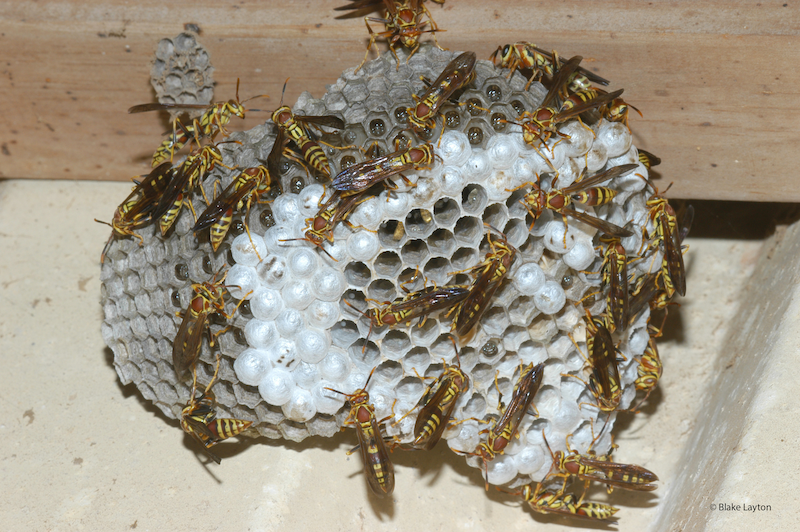Guinea Wasps, Vol. 8, No. 17
Related News
June 20, 2013
April 11, 2013
April 2, 2013
March 14, 2013

I had come home from graduate school for the 4th of July weekend, and Dad asked my younger brother and me to go help him move some cows from “across the creek.” My brother quickly jumped in the pick-up, allowing me to have the coveted window seat—Dad’s trucks never had air conditioning. This should have alerted me, but I foolishly interpreted this as a long overdue sign of deference to his elder brother. It was not until we pulled up to the pasture gate that I understood the real reason for younger brother’s hast in claiming the center seat.
The gate was one of those galvanized panel farm gates, the kind with lots of prime spots for Guinea wasp nests, and it probably had not been opened since early spring, as Dad usually entered this pasture through another gate. There were two nests and, of course, one was right in the latch that had to be slid back to open the gate. I managed to get that gate open without getting stung, but not without providing some, apparently hilarious, entertainment for my Dad and brother!
Anyone who has ever unwittingly bumped into a Guinea wasp nest well understands the basis for their specific name, Polistes exclamans. You just can’t help but exclaim something! These little wasps are not overly aggressive and will usually tolerate a surprising amount of encroachment without reacting. But once their nest is jarred or disturbed, they react quickly and viciously.
Guinea wasps are one of the more common species of paper wasps in the Southeast. They build their nests in places protected from rain: under eaves, in storage sheds, in infrequently used equipment, in barbeque grills, in thick shrubbery, in galvanized panel farm gates, etc. If you have lived long in the South, you can undoubtedly add to this list. Red Wasps and Carolina Paper Wasps nest in similar situations, though there are subtle differences in preferred nest sites.
The point of this article is to encourage readers to avoid stings this summer by learning to be “wasp-wise.” Be aware of the kinds of places paper wasps nest and use appropriate caution when working near such areas. Shake those shrubs with a long-handled tool to check for wasps before you wade in to prune them. Is this the first time you’ve used that grill this summer? Be careful opening the lid. Check that fertilizer spreader before you take it down from its hook in the storage shed. You get the idea. The longer one lives in the South, the more “wasp-wisdom” one gains. Unfortunately, as with many other areas of life, much of this is learned through painful experience. Growing up on a farm, my brother became wasp-wise early in life.
Control: Keep a can of aerosol wasp spray handy to deal with wasp nests you find in places they just can’t be allowed to stay. Control small nests as soon as you spot them. A nest that has two or three adult wasps in early May will have dozens of workers by August. Always use appropriate caution when dealing with stinging insects; there is always a risk of getting stung.
See pages 12-14 of Extension Publication 2331, Control Insect Pests in and around the Home Lawn for more information on dealing with wasps, bees, and yellowjackets.
Blake Layton, Extension Entomology Specialist, Mississippi State University Extension Service.
The information given here is for educational purposes only. Always read and follow current label directions. Specific commercial products are mentioned as examples only and reference to specific products or trade names is made with the understanding that no discrimination is intended to other products that may also be suitable and appropriately labeled.
Mississippi State University is an equal opportunity institution.
Bug’s Eye View is now on Facebook. Join the Bug's Eye View Facebook group here.